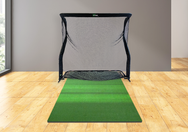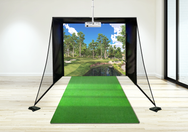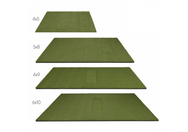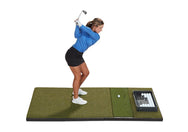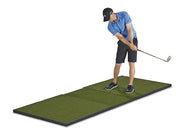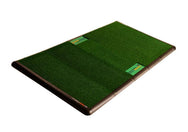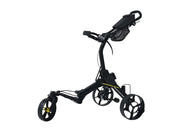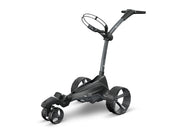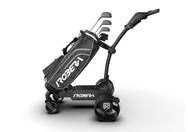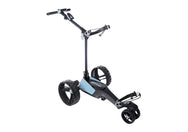Introduction to launch monitors: The game-changer for golfers
Launch monitors have revolutionized how golfers of all levels understand and improve their game. Think of them as your personal golf coach, capable of providing instant feedback on each shot. Whether you’re hitting at the range or playing a round, these compact devices analyze everything from ball speed, spin rate, launch angle, carry distance, and more.
Simply put, a launch monitor breaks down the science of your swing and shot, giving you clear data to work on. No guesswork, just straight facts. This tech isn’t just for the pros on TV; it’s accessible to anyone looking to take their game up a notch. By understanding the numbers behind your shots, you can make informed adjustments to your stance, swing, or club choice, ultimately leading to lower scores and more enjoyable rounds. In essence, if you’re serious about golf, tapping into the insights a launch monitor offers can be a total game-changer.

Understanding how launch monitors work
Launch monitors are tech gadgets that track what happens to your golf ball when you hit it. They’re like your personal golf coaches, giving you feedback so you can improve your game.
Here’s the deal: when you strike the ball, the monitor measures a bunch of stuff like speed, angle, spin, and distance. Most launch monitors are using either a doppler radar or cameras or combination of both to see everything in real-time. This data is gold because it tells you exactly what’s happening with your swing and how the ball reacts. By understanding these numbers, you can tweak your swing, choose the right clubs, and aim better.
In short, launch monitors take the guesswork out of your practice, making your time on the range way more effective. Whether you’re trying to add yards to your drive or hit your irons more consistently, getting to know how a launch monitor works is the first step in upping your golf game.
Key benefits of using launch monitors for your golf game
Launch monitors do more than just tell you how far the ball went. They’re like a personal coach, giving you detailed insights about every shot.
First up, they measure your ball speed, launch angle, spin rate, and more. This data helps you understand what’s happening each time you strike the ball, letting you make tweaks to improve.
For example, maybe you’re hitting it too high or spinning it too much. With a launch monitor, you’ll see that and adjust. Another huge plus is they help with club fitting. By knowing your shot stats, you can find the perfect clubs for your style, boosting your confidence and game. Also, practicing with a launch monitor makes every session count. Instead of just hitting balls, you’re focused on specific aspects of your game. Lastly, they’re not just for the range. Many are portable, so you can use them anywhere. Whether you’re a newbie or trying to go pro, a launch monitor can seriously up your golf game.
From basics to advanced: Different types of launch monitors available
In the golf world, knowing your swing is key. That’s where launch monitors come in, serving up critical data to hone your game. Think of them as your personal golf coach, but in tech form. There are a few main types you’ll encounter.
First up, Doppler radar-based monitors such as FlightScope Mevo+, Garmin Approach R10, Swing Caddie SC4, Rapsodo MLM2PRO, and Full Swing KIT. Picture the tech behind weather forecasts but tailored for golf. These gadgets measure ball flight and provide a heap of data. They’re portable, so you can lug them to the range or course easily.
Then, there’s the camera-based systems such as SkyTrak+, Bushnell Launch Pro, Foresight Sports GC3 and GCQuad, Uneekor EYE MINI and EYE MINI LITE. These launch monitors capture your swing and the ball’s journey in high definition. They pinpoint ball speed, angle, and spin, giving you that edge to tweak your swing just right. Though pricier and less mobile than radar systems, the detail they offer is unmatched.
From basic models that give you straight-up data like speed and distance, to advanced systems offering insights on launch angle, spin rates, and more, there’s a monitor for every level of golfer. Whether you’re just starting or eyeing the pro league, selecting the right launch monitor could be your game changer.
How to choose the right launch monitor for your skill level
Choosing the right launch monitor boils down to why you play. For casual weekend golfers, an entry-level launch monitor such as Swing Caddie SC100, Swing Caddie SC200 PLUS, Swing Caddie SC300i does the trick. These devices measure basic data like carry distance and speed, which is plenty for seeing how far you thump that ball. You won’t need to break the bank; models start at a couple of hundred bucks.
Now, if you’re all about shaving off strokes and getting serious, mid-range golf launch monitors such as SkyTrak+, Mevo+, Bushnell Launch Pro, or Uneekor EYE MINI LITE step up the game. They track more - think angle of your shots, spin, and even simulate real-world conditions. Prices jump to the thousands, but it’s still within the “reasonable” for dedicated hobbyists.
Elite players, we’re talking near or at pro level, should eye the high-end golf launch monitors such as Foresight Sports Falcon or GCQuad MAX, TruGolf APOGEE, or Uneekor EYE XO2. These units are an investment, packing in everything from detailed ball flight analytics to full-blown course simulation. Yes, they can cost as much as a small car, but for those in it to win it, it’s the closest to having a personal coach without the actual person.
Remember, it’s about matching the tool to your ambition. Don’t overspend for features you won’t use, but don’t shortchange your potential by going too basic.
Setting up your launch monitor for maximum effectiveness
Setting up your launch monitor right is like picking the perfect golf club. It can make or break your game. First, place it directly behind or next to the ball, depending on the model. Accuracy is key, so ensure it’s on a flat surface. Most monitors require about 12ft of width, 9ft of height, and 12-18ft of depth to accurately capture data. Keep it in a spot where you can easily see the feedback after each swing without disrupting your flow.
Next, calibrate it for the environment. If you’re outside, factor in weather conditions like wind and humidity. Indoors? Make sure there’s enough space. Before diving into a session, spend time understanding what each metric means. Ball speed, launch angle, spin rate - these aren’t just numbers. They’re insights into how to tweak your swing for the better. Lastly, don’t set and forget. Regularly update your launch monitor’s software and recalibrate it to ensure you’re getting the most precise readings. Getting comfortable with these steps turns a piece of tech into your personal coach, always ready to guide you from amateur strokes to pro-level swings.
Interpreting data from your launch monitor: What does it all mean?
So, you’ve got a launch monitor. Great. Now, it’s like someone handed you a map in a language you don’t understand. Let’s break it down, easy style.
First up, ball speed. This is how fast your ball jets off when you hit it. More speed, more distance. Simple.
Then, there’s launch angle. This is about how high the ball goes. Too low or too high, and you’re losing distance. You want it just right.
Spin rate comes next. It’s how much your ball spins in the air. Less spin on your drives gives you more distance; for short shots, more spin is your friend.
Now, carry distance. This one’s straightforward—it’s how far the ball travels before it hits the ground. Crucial for choosing the right club.
Club speed tells you how fast you’re swinging. Faster swing, potentially more distance—just make sure it’s controlled.
And last, smash factor. Sounds cool, right? It’s the ratio of ball speed to club speed. Higher number here means you’re hitting the ball efficiently.
Get these basics down, and you’ll start turning that data into real improvements on the course. No need to thank me, just go out there and crush it.
Training techniques with launch monitors: Practical tips to improve
Golf launch monitors are your secret weapon in hitting those golf goals. Picture this: real-time feedback on every swing, pinpointing exactly where you need to improve. Here’s how to use one effectively.
First, focus on your consistency. Launch monitors measure speed, angle, and spin, letting you see patterns in your game. Aim to make your shots as uniform as possible.
Next, work on your accuracy. Use the data to adjust your technique, aiming to hit your target more often. Also, don’t ignore the distance stats. They’ll show if you’re really getting the most out of your swing or if there’s power you’re not tapping into.
Lastly, keep track of your progress. Regular sessions with a launch monitor can show you how much you’ve improved over time, making it clear what works for you. In short, lever up your practice by using a launch monitor. It’s about smart training, not just hard training.
Real-life success stories: How launch monitors transformed golf games
Many golfers, from weekend warriors to aspiring pros, have seen their game transform with the help of launch monitors. Take Alex, an amateur golfer who struggled to break 90 consistently. Frustrated, he turned to a launch monitor to get a detailed look at his swing. This tool gave him insights into his swing speed, ball spin, and launch angle. With practice and data, Alex refined his technique. Within months, he was not just breaking 90; he was shooting in the low 80s.
Then there’s Jamie, a high school golfer with dreams of playing in college. By incorporating a launch monitor into her practice, she was able to focus on her weaknesses. She discovered her launch angle was too low for optimal distance. Adjusting her stance and swing, Jamie added 20 yards to her drives, catching the eye of college scouts.
Launch monitors aren’t magic, but they offer the kind of feedback that can make a real difference. They turn what feels right into what is proven to be effective, taking the guesswork out of golf improvement. In essence, these success stories underline a simple truth: understanding your game at a granular level can lead to significant improvements. It’s not about swinging harder, but smarter.
Investing in a launch monitor: Costs, considerations, and conclusion
Launch monitors are not cheap, but the right one can transform your game. The price can range from a few hundred bucks to over $20,000. Yes, you heard that right. But here’s the deal – you don’t need the fanciest gear to see improvement. Start with what fits your budget and what you aim to achieve in your game.
First off, basic units that track simple data like ball speed, swing speed, carry distance, and smash factor might set you back around $180 - $400. These are great for the casual golfer looking to understand their shots better without breaking the bank.
For the more serious golfers among us, mid-range monitors offer a deeper dive into your performance. We’re talking club path, face angle, and even more precise carry distances. Expect to shell out $600 - $7,000 for this level of detail.
Lastly, for the pros and the dreamers aiming to reach that level, top-tier systems provide all the bells and whistles. Advanced analytics, video replay, and the ability to simulate famous golf courses can cost anywhere from $7,000 - $20,000.
Besides the price tag, consider how you’ll use it. Are you practicing indoors or out? Do you want to geek out over every possible metric, or do you simply want to know how far you hit your 7 iron? And don’t forget, the more features you want, the more you’ll pay.
In conclusion, a launch monitor is a solid investment for anyone serious about golf. Match your needs with your budget, and you’ll find the perfect tool to help lower your scores and enjoy the game even more. Remember, it’s not about having the most expensive gear but the right gear to improve your game.




